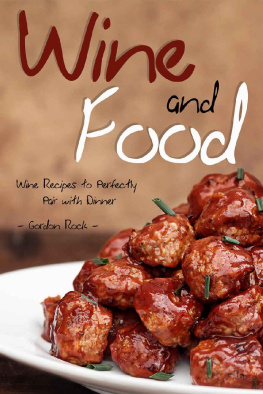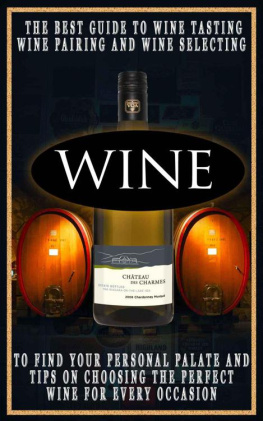Morrison - Wine Making: The Complete Guide To Making Organic Wine at Home Includes 23 Homemade Wine Recipes
Here you can read online Morrison - Wine Making: The Complete Guide To Making Organic Wine at Home Includes 23 Homemade Wine Recipes full text of the book (entire story) in english for free. Download pdf and epub, get meaning, cover and reviews about this ebook. year: 2015, genre: Home and family. Description of the work, (preface) as well as reviews are available. Best literature library LitArk.com created for fans of good reading and offers a wide selection of genres:
Romance novel
Science fiction
Adventure
Detective
Science
History
Home and family
Prose
Art
Politics
Computer
Non-fiction
Religion
Business
Children
Humor
Choose a favorite category and find really read worthwhile books. Enjoy immersion in the world of imagination, feel the emotions of the characters or learn something new for yourself, make an fascinating discovery.
- Book:Wine Making: The Complete Guide To Making Organic Wine at Home Includes 23 Homemade Wine Recipes
- Author:
- Genre:
- Year:2015
- Rating:5 / 5
- Favourites:Add to favourites
- Your mark:
- 100
- 1
- 2
- 3
- 4
- 5
Wine Making: The Complete Guide To Making Organic Wine at Home Includes 23 Homemade Wine Recipes: summary, description and annotation
We offer to read an annotation, description, summary or preface (depends on what the author of the book "Wine Making: The Complete Guide To Making Organic Wine at Home Includes 23 Homemade Wine Recipes" wrote himself). If you haven't found the necessary information about the book — write in the comments, we will try to find it.
Wine Making: The Complete Guide To Making Organic Wine at Home Includes 23 Homemade Wine Recipes — read online for free the complete book (whole text) full work
Below is the text of the book, divided by pages. System saving the place of the last page read, allows you to conveniently read the book "Wine Making: The Complete Guide To Making Organic Wine at Home Includes 23 Homemade Wine Recipes" online for free, without having to search again every time where you left off. Put a bookmark, and you can go to the page where you finished reading at any time.
Font size:
Interval:
Bookmark:
Wine Making:
The Complete Guide To Making Organic Wine at Home Includes 23 Homemade Wine Recipes
So youve decided to embark on your own, personal winemaking adventure. Congratulations! Winemaking is not a difficult process, but it requires a certain set of skills and patience in order to successfully create a truly delicious bottle of wine.
In this book you will learn about the history of winemaking, its importance to world cultures, and how you can make your own wine with the proper equipment and ingredients. But before we get started, wed like to show you the basic process for making wine.
- Combine fruits, sugar, water, sulfite, pectic enzymes, and other ingredients necessary for each wine.
- Let this mixture known as Must sit for 1 day.
- Add yeast to your mixture.
- Transfer to your primary fermenter for 3-5 days, sometimes a week depending.
- Transfer to airtight, secondary fermenter for a few months, depending, and store in a cool place.
- Strain and siphon would-be wine into airtight containers for aging, usually for a few more weeks.
- Transfer into bottles, cork, and let age until wine meets its flavor potential, anywhere from 6 months to a year.
As you read this book and collect your fermenters, siphons, bottles, and other tools, you will follow this same basic process for each batch of wine. Of course, depending on flavors, sweetness, and your desired alcoholic content, you may want to change the process around.
Once you learn how to make wine, changing the process will only help you learn more as you work toward cultivating a truly unique wine flavor.
Table of Contents
Introduction
At-Home Winemaking 101
Chapter 1 The History of Wine
Chapter 2 Necessary Equipment & Ingredients for Modern Winemaking
Chapter 3 Making Wine at Home: Tips, Tricks, and Common Mistakes
Chapter 4 23 Favorite Winemaking Recipes
Basic Dandelion Wine
Crockpot Dandelion Wine
Dandelion Wine with Raisins
Ginger Dandelion Wine
Strawberry Wine
Frozen Strawberry Wine
Elderberry Wine
Watermelon Wine
Peach Wine
Peach Evening Wine
Pear Wine Recipe
Basic Fig Wine Recipe
Sweet Fig Wine Recipe
Fresh Fig Wine Recipe
Blackberry Wine
Sweet Blackberry Honey Wine
17. Chokecherry Wine Recipe
Pomegranate Wine Recipe
Rose Petal Wine Recipe
Sake Rice Wine Recipe
Beet & Raisin Wine Recipe
Easy Plum Wine Recipe
Sherry Wine Recipe
Chapter 5 Popular Meal Pairings for Your Homemade Wines
Chapter 6 Selling Your Homemade Wine for Profit
Conclusion
The glass of wine you sip on at dinner, over a delicious dessert with friends, or toast with during a black tie affair has roots dating all the way back to Mesopotamia. Ancient cultures were fermenting fruits for as long as agriculture has been a part of human history.
Ancient Egyptian pharaohs were buried with bottles of aged wine, and the ancient Greeks used imbibed during their symposiums.
But it was the Romans who brought wine into the public sphere, opening up bars in every major city and port, and exporting their wine across the empire.
Before wine became a social lubricant, and long before winemaking became a hobby, the drinking of wine was mostly reserved for religious and ceremonial purposes. The Egyptians believed the red color of wine resembled blood and held within it metaphysical properties for the gods.
It was most often used in burial rituals as an offering before sealing away the deceased in their tomb. Of course, its religious purposes did not deter the royal and upper classes from imbibing on the alcoholic treat.
Wine was used in celebrations, and with this in mind, the Egyptians buried their dead with wine in hopes that they would continue entertaining guests in the afterlife.
The Greeks took on this mentality and used wine as a part of their social symposiums. While they discussed philosophy, mathematics, and history (among many other subjects), the drinking of wine was believed to open up the mind intellectually as well as spiritually.
For the Greek religion also celebrated wine. Dionysus, the god of wine, was noted as the inspiration for philosophers and artists alike, and he was commemorated at nearly every symposium as well as during specific months out of the year.
During the Mycenean Period in Greece (1600-1100B.C.), winemaking was perfected as different cities created different flavors and varieties based on their local climates.
The diversity of tastes and colors were in high demand, and the Greeks traded their wines across the ancient world.
They taught their colonies in Italy how to make wine, and took advantage of the Italian countrysides ability to grow grapes. Later, Alexander the Great would take Greek winemaking as far as Asia.
Unfortunately, during this time, both the making and consumption of wine was limited to the upper-classes who had both the money and the time to devote to such entertainments.
It was not until the Roman Empire took what the Greeks had taught them and shared it with the public masses that wine and winemaking took off as a popular past time. There were wine bars on every street in every city in the empire.
Winemaking had become so prevalent that the Emperor Domitan had to legally ban the building of more vineyards in order to make room for wheat fields during the 2 nd century.
But by this time, every empire in the known world was fermenting their own, local fruits for delectable wines which they were trading with palates all over the globe.
These ancient vinos would make wine by treading fruit with their feet, stomping out the juice and letting it drain into a large stone basin beneath them.
The juice squeezed out by feet was considered more potent and medicinal than the juice yielded by pressing, so stomping was always the first step followed by 2-3 more pressings by stone.
These juices would then be stored in large, earthenware jars and buried in the dirt beneath houses and barns to stay cool during the month of fermentation.
After 30 days, the liquid would be transferred to jars for storage, with chalk or marble dust sometimes being added to sweeten the flavor.
Holes would be drilled in the top of these jars in order to allow the carbon dioxide to escape, which is imperative to preventing the oxidation and spoiling of wine.
Today, you do not have to use your feet in the modern winemaking process (unless you want to). But many of the techniques and equipment used are directly inspired by our ancestors.
Even the ancients knew that winemaking was a process that required a lot of unique tools and even more patience.
The amount of time it takes to ferment your own wine can range anywhere between 3 months to 3 years, and the equipment you choose to use will determine the flavor and color of your unique bottle of wine.
Unlike our ancestors, the 21 st century offers a few key advancements in the realm of winemaking at home. One of these are the starter kits that many vineyards and wine companies offer to individual winemakers to get them started on their first 5 gallons of homemade wine.
These starter kits will typically come with a primary fermenter (usually a large glass bottle), a secondary fermenter or aging vessel (a separate bottle, made of glass or plastic), air tight lids, tubes for siphoning, wine bottles, impact corkers, a thermometer and hydrometer, and sodium metabisulfite for cleaning.
You can choose to purchase these starter kits, or you can collect your own equipment. But, as any seasoned winemaker will tell you, the most important tool you have will be your sulfite.
Font size:
Interval:
Bookmark:
Similar books «Wine Making: The Complete Guide To Making Organic Wine at Home Includes 23 Homemade Wine Recipes»
Look at similar books to Wine Making: The Complete Guide To Making Organic Wine at Home Includes 23 Homemade Wine Recipes. We have selected literature similar in name and meaning in the hope of providing readers with more options to find new, interesting, not yet read works.
Discussion, reviews of the book Wine Making: The Complete Guide To Making Organic Wine at Home Includes 23 Homemade Wine Recipes and just readers' own opinions. Leave your comments, write what you think about the work, its meaning or the main characters. Specify what exactly you liked and what you didn't like, and why you think so.














